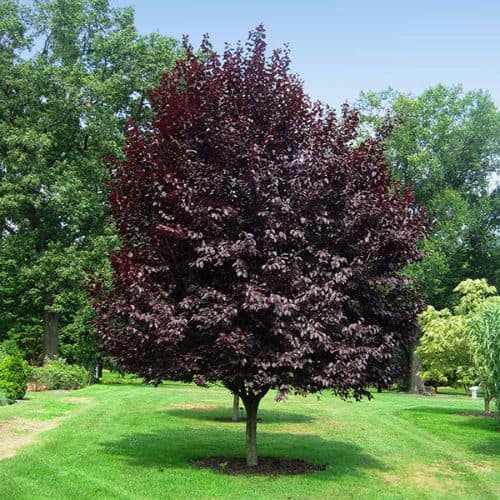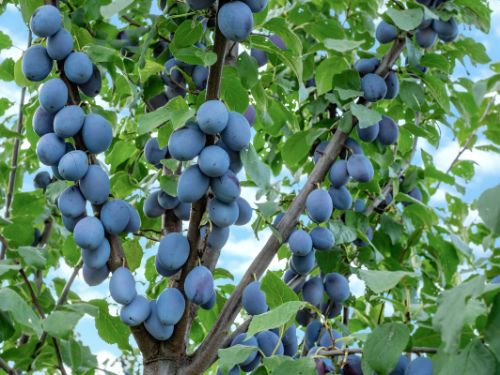The Plum tree, a proud member of the Prunus genus, is renowned for its luscious fruit, fragrant blossoms, and charm. Originating from regions across Asia, Europe, and North America, this tree has become a cherished addition to gardens worldwide. Over the centuries, the cultivation of different Plum varieties has flourished, resulting in a diverse array of flavors, colors, and forms.

Growing And Caring For Plum Trees
When planting a Plum tree, selecting an appropriate location is key. These trees thrive in well-drained soil that is rich in organic matter. Adequate sunlight is crucial for optimal growth and fruit production, so choose a site that receives full sunlight. While Plum trees can tolerate a range of soil types, they prefer slightly acidic to neutral soil conditions.
Regular watering, especially during dry spells and the growing season, is essential for the establishment and overall health of the tree. Mulching around the tree’s base helps retain soil moisture, regulate temperature, and suppress weeds. Pruning is another critical aspect of Plum tree care, focusing on shaping the tree, removing dead or diseased branches, and promoting good air circulation. Pruning is often done during the dormant season, contributing to the tree’s overall vigor and fruit-bearing capacity.
Plum trees are relatively cold-hardy, making them suitable for various temperate climates. However, they also require several chilling hours during winter to break dormancy and produce fruit successfully. Selecting Plum varieties well-suited to the local environment ensures a thriving and fruitful tree.
Size, Shape, and Growth Rate
The size and shape of Plum trees can vary widely, influenced by factors such as the specific variety, rootstock used, and local growing conditions. Dwarf and semi-dwarf varieties are popular for smaller gardens, while standard-sized Plum trees can reach heights of 15 to 20 feet (4.5 to 6 meters) or more. The overall shape of Plum trees is typically rounded or spreading, with branches extending outward to create a well-balanced canopy.
Generally, these trees exhibit a moderate growth rate, allowing for steady development and a robust structure. While they may not grow as rapidly as some other fruit trees, their moderate growth rate contributes to their longevity and ability to adapt to changing conditions. Adequate water, sunlight, and appropriate care practices contribute to Plum trees’ overall health and growth.
Leaves, Flowers, And Fruit
The combination of leaves, flowers, and fruit makes Plum trees dynamic and multi-faceted contributors to the garden landscape. The progression from the fresh greenery of spring leaves to the ethereal blossoms and, finally, the colorful and succulent fruit creates a narrative of seasonal change and abundance. The leaves provide a consistent backdrop, evolving through the seasons, while the flowers mark the arrival of spring with a burst of fragrance and color. As the flowers give way to the developing fruit, the tree’s purpose becomes evident, and the garden is rewarded with a harvest of flavorful Plums.
The fruit is the crowning glory of these trees, offering a delectable reward for both gardeners and nature alike. The fruit’s skin is often smooth and may have a subtle bloom, adding to its visual appeal. The flesh of Plums is juicy and succulent, with a flavor spectrum that spans from sweet to tart. The shape and size of the fruit can vary, ranging from round to oval, and some varieties produce freestone fruits, making them easier to enjoy fresh or used in culinary applications. The abundance of Plum fruits makes them a prized addition to orchards and gardens and provides opportunities for culinary creativity, including fresh eating, jams, jellies, pies, and preserves.

Uses in Gardening and Landscaping
Plum trees hold a central role in both edible landscaping and ornamental gardens, offering a multitude of uses and benefits. The primary allure lies in their delectable fruits, which come in various flavors, colors, and sizes. From sweet to tart, red to purple, and small to large, Plum varieties cater to diverse culinary preferences. Home gardeners often delight in planting Plum trees for fresh consumption, jams, jellies, and baking, making them valuable to orchards and backyard fruit gardens.
Beyond their culinary contributions, Plum trees enhance the aesthetic appeal of gardens with their spring blossoms and lush foliage. Their rounded or spreading canopy provides shade and is a focal point in the landscape. Plum trees can be strategically planted to create visual interest, define garden boundaries, or complement other ornamental plants. Dwarf and semi-dwarf varieties are well-suited for smaller spaces, including container gardening on patios or balconies.
Plum trees can also be used in larger landscapes, such as parks, public gardens, and urban green spaces. Their versatility and adaptability to various soil types and climates make them valuable assets in landscaping projects. Plum trees can be incorporated into mixed plantings, providing seasonal interest and ecological benefits. They attract pollinators, support biodiversity, and contribute to outdoor environments’ overall beauty and functionality.
Frequently Asked Questions
Are Plum Trees Self Pollinating?
Plum trees are not always self-pollinating, but some varieties can produce fruit with their own pollen. Many plum tree varieties benefit from cross-pollination, where pollen from one tree fertilizes the flowers of another tree. Cross-pollination often results in better fruit sets and increased yields. If you need clarification on whether your plum tree is self-fertile or requires a pollination partner, it’s a good idea to research the specific variety you have or consult with a local nursery or gardening expert.
Do Plum Trees Flower Or Leaf First?
Plum trees typically flower before they leaf out. In temperate climates, plum trees usually bloom in early spring, often before the new leaves emerge. The flowers appear on bare branches or alongside emerging foliage, depending on the specific variety and local growing conditions. The blossoms are often one of the first signs of spring and can range in color from white to various shades of pink, depending on the cultivar.
How Long Until Plum Trees Bear Fruit?
Generally, plum trees grown from grafted saplings or cuttings can start bearing fruit sooner than those grown from seeds. Grafted trees are typically clones of a parent tree known to produce desirable fruit and can start producing fruit within 2 to 4 years after planting, though this can vary.
Plum trees grown from seeds take longer to mature and bear fruit. Seed-grown plum trees can take 4 to 7 years or more to reach maturity and produce fruit. Additionally, seed-grown trees may not produce fruit that is true to the parent tree’s characteristics, as they can exhibit variations due to genetic factors. Proper pruning, fertilization, adequate sunlight, and pollination also play important roles in fruit production.
